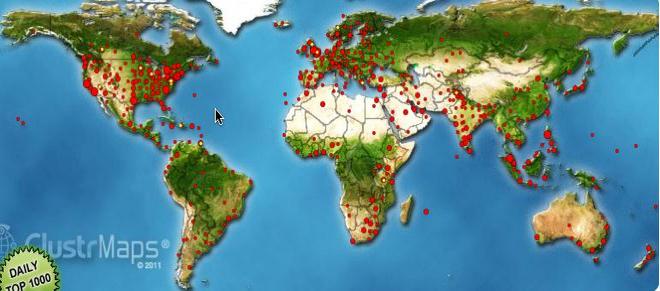
 |
Terry Anderson
Editor, IRRODL
You will see below that once again IRRODL authors, reviewers, and editors have produced a fine multinational set of research papers relating to important topics in open and distance learning. I also note that we have just exceeded 5,600 subscribers to IRRODL and am gratified of this support.
The ClustrMap below illustrates the geographic diversity and the quantity of readers currently accessing IRRODL. In the 5 days from Feb 18-22, 2013, 7,458 unique visitors (or 1,492 per day) learned from the IRRODL archive of articles and reviews.

Our first article of this first issue of 2013, « Green Curriculum: Sustainable Learning in Higher Education, » focuses on ways to reduce the environmental impact of open and distance learning (ODL) institutions. This South African researcher reviews the need for ODL institutions to be active proponents and participants in green initiatives, including the most natural calling to teach students how to live within the constraints (and opportunities) of our bounded globe.
In the second paper, « A Predictive Study of Student Satisfaction in Online Education Programs, » the American authors examine the relationship between student satisfaction and a host of demographic and instructional design variables using regression analysis. As expected, the answers are complex, but I was not surprised to see the relationship between satisfaction and student-teacher and student-content interaction. Interesting, as well, in this year of the MOOC, that only the latter (student-content interaction) is scaleable.
I have long contended that too great a proportion of open and distance learning research takes place in formal education courses and especially with the tiny subset of graduate students studying education. However in the next article, « On-the-Job E-Learning: Workers’ Attitudes and Perceptions, » Spanish researchers focus on the perceptions and expectations of workers and employers. As expected employers love the potential cost savings of e-learning while workers also acknowledge the advantages, but retain a fondness of face-to-face training opportunities as well.
Last month I was fortunate to be able to visit the Commonwealth of Learning and their new president Dr. Asha Kanwar. I was pleasantly surprised to see the number and variety of open educational resources as well as a host of training and research products, championing the value of OER for cost-effective educational development. This next article from India presents « An OER Architecture Framework: Need and Design. » The framework is designed to provide a conceptual organization to OER development, distribution, use, and reuse.
In this issue’s next article from South Africa, « Development of ODL in a Newly Industrialized Country According to Face-to-Face Contact, ICT, and E-Readiness, » researchers investigate the attitudes of student teachers towards use of ODL in their programs. Not surprisingly, their acceptance is associated with their personal e-readiness, which to me underlines the necessity for both students and teachers actively developing their net presence and net efficacy.
Distance students have traditionally been older students who are more concerned with jobs and families than traditional campus students. Thus, this study from Portugal, «Employability in Online Higher Education: A Case Study, » very usefully researches both students and teachers ideas about the need for employability skills and attitudes to infuse online university programming. As expected both groups have many similar views, but a few interesting differences are also revealed.
Since we know that education and learning are culturally bound activities, it is rare to find an OER that perfectly matches the unique needs of any particular student group. Fortunately, good OER can be remixed so as to customize the learning activities and outcomes. In this article « Identifying Barriers to the Remix of Translated Open Educational Resources, » a Brazilian researcher seeks to understand the barriers that inhibit or prohibit effective mixing of OER.
Researchers sometimes wonder if anyone ever reads the work they publish in journals (well, excepting articles in IRRODL, which of course are hot topics in online and campus coffee rooms around the world!). In « Uses of Published Research: An Exploratory Case Study, » a Canadian researcher examines the impact of 10 articles that he has published over the past decade. He concludes with advice for authors to insure their work is not ignored.
Many of the ‘pioneer’ open learning institutions founded in the last half of the 20th century emerged within a technology and an industrial culture of print production of learning content. As both technology and the industrial culture have changed, many of these institutions are struggling to reinvent themselves for an online era. In « A Framework for Developing Competencies in Open and Distance E-Learning, » a researcher from the Philippines investigates how the distance education workplace has changed and the challenges and opportunities associated with these changes.
I had the pleasure of visiting Sweden last year and observing the peer–review system described in « Peer Portal: Quality Enhancement in Thesis Writing Using Self-Managed Peer Review on a Mass Scale » in action. I must say I was impressed. The supervision of thesis students has always been a challenge to distance educators in large part because we have not yet been able to scale the support and delivery of thesis supervision, thus increasing cost and/or constraining opportunities. In a classic substitution, student-student interaction is, to some degree, substituted for student-teacher interaction and the whole process made persistent and transparent through a unique data base system.
I am pleased to see that our next article focuses on the diverse forms of open and distance learning that are emerging beyond the group, namely in networks and collectives. In « Learning in Multiple Communities from the Perspective of Knowledge Capital, » Turkish authors overview the opportunities provided by emergent social structures that have potential to move beyond course- and group-based learning and to bridge to lifelong learning of teachers and students.
Progressing even further beyond the classroom door (online or physical) we see how « A Multimedia Approach to ODL for Agricultural Training in Cambodia » affects the real lives of rural farmers. As expected comparison between face-to-face and online instruction showed little difference in outcomes, but savings in time and cost and increased flexibility, as always, provided advantages for students and teachers using ODL methods.
The allure of artificial intelligence and its promise of being able to automatically assess and personalize learning has long fascinated many of us. In this more technical article titled « Automatic Evaluation for E-Learning Using Latent Semantic Analysis: A Use Case, » Spanish authors overview latent semantic technology developments and an application used for assessing students at a distance.
Finally, in the Field Notes section, American authors document one of the most far-reaching innovations in Western secondary education, that of an open school that uses 100% open content. In « “Opening” a New Kind of School: The Story of the Open High School of Utah, » the authors recount the successes and the challenges of bringing quite radical reforms even to the current (and very youthful) first generation of online high schools.
As always, we end this editorial with a sincere thanks to all who make IRRODL happen: First to our sponsor Athabasca University, second to our authors and reviewers, and finally to our 5,600 (and counting!) subscribers.
We have updated our list of reviewers’ names on the IRRODL Web site from 2012. You too may see your name in print by volunteering to review IRRODL articles. The volume of submissions continues to increase at IRRODL, and I try to assign only one review a year, so we need more reviewers. You may volunteer by logging into the IRRODL system and checking the reviewer checkbox in your profile. But please also add a few areas of interest and expertise to the “Reviewing Interests” box, so that I can match your interests with the work of potential IRRODL authors.
Best of the year 2013, the year of the Snake, Islamic year 1434, Ugadi, and the many other celebrations of this time of year to all IRRODL readers!